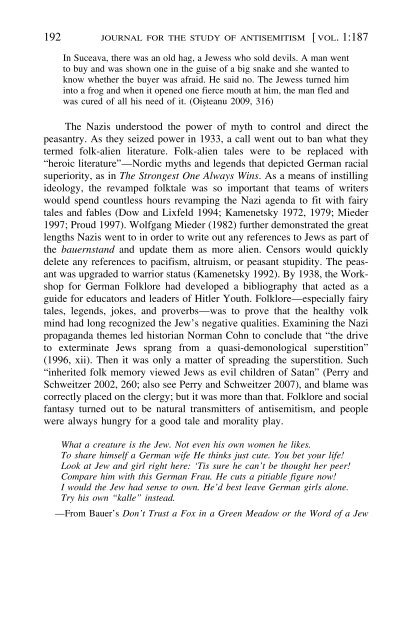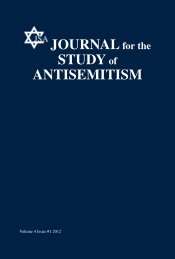Journal for the Study of Antisemitism
Journal for the Study of Antisemitism
Journal for the Study of Antisemitism
Create successful ePaper yourself
Turn your PDF publications into a flip-book with our unique Google optimized e-Paper software.
192 JOURNAL FOR THE STUDY OF ANTISEMITISM [ VOL. 1:187<br />
In Suceava, <strong>the</strong>re was an old hag, a Jewess who sold devils. A man went<br />
to buy and was shown one in <strong>the</strong> guise <strong>of</strong> a big snake and she wanted to<br />
know whe<strong>the</strong>r <strong>the</strong> buyer was afraid. He said no. The Jewess turned him<br />
into a frog and when it opened one fierce mouth at him, <strong>the</strong> man fled and<br />
was cured <strong>of</strong> all his need <strong>of</strong> it. (Oi¸steanu 2009, 316)<br />
The Nazis understood <strong>the</strong> power <strong>of</strong> myth to control and direct <strong>the</strong><br />
peasantry. As <strong>the</strong>y seized power in 1933, a call went out to ban what <strong>the</strong>y<br />
termed folk-alien literature. Folk-alien tales were to be replaced with<br />
“heroic literature”—Nordic myths and legends that depicted German racial<br />
superiority, as in The Strongest One Always Wins. As a means <strong>of</strong> instilling<br />
ideology, <strong>the</strong> revamped folktale was so important that teams <strong>of</strong> writers<br />
would spend countless hours revamping <strong>the</strong> Nazi agenda to fit with fairy<br />
tales and fables (Dow and Lixfeld 1994; Kamenetsky 1972, 1979; Mieder<br />
1997; Proud 1997). Wolfgang Mieder (1982) fur<strong>the</strong>r demonstrated <strong>the</strong> great<br />
lengths Nazis went to in order to write out any references to Jews as part <strong>of</strong><br />
<strong>the</strong> bauernstand and update <strong>the</strong>m as more alien. Censors would quickly<br />
delete any references to pacifism, altruism, or peasant stupidity. The peasant<br />
was upgraded to warrior status (Kamenetsky 1992). By 1938, <strong>the</strong> Workshop<br />
<strong>for</strong> German Folklore had developed a bibliography that acted as a<br />
guide <strong>for</strong> educators and leaders <strong>of</strong> Hitler Youth. Folklore—especially fairy<br />
tales, legends, jokes, and proverbs—was to prove that <strong>the</strong> healthy volk<br />
mind had long recognized <strong>the</strong> Jew’s negative qualities. Examining <strong>the</strong> Nazi<br />
propaganda <strong>the</strong>mes led historian Norman Cohn to conclude that “<strong>the</strong> drive<br />
to exterminate Jews sprang from a quasi-demonological superstition”<br />
(1996, xii). Then it was only a matter <strong>of</strong> spreading <strong>the</strong> superstition. Such<br />
“inherited folk memory viewed Jews as evil children <strong>of</strong> Satan” (Perry and<br />
Schweitzer 2002, 260; also see Perry and Schweitzer 2007), and blame was<br />
correctly placed on <strong>the</strong> clergy; but it was more than that. Folklore and social<br />
fantasy turned out to be natural transmitters <strong>of</strong> antisemitism, and people<br />
were always hungry <strong>for</strong> a good tale and morality play.<br />
What a creature is <strong>the</strong> Jew. Not even his own women he likes.<br />
To share himself a German wife He thinks just cute. You bet your life!<br />
Look at Jew and girl right here: ‘Tis sure he can’t be thought her peer!<br />
Compare him with this German Frau. He cuts a pitiable figure now!<br />
I would <strong>the</strong> Jew had sense to own. He’d best leave German girls alone.<br />
Try his own “kalle” instead.<br />
—From Bauer’s Don’t Trust a Fox in a Green Meadow or <strong>the</strong> Word <strong>of</strong> a Jew














